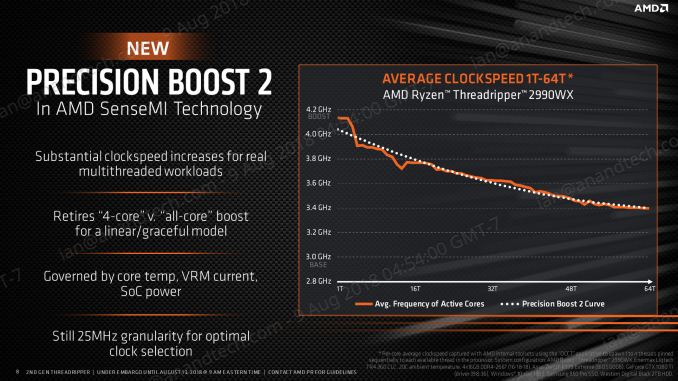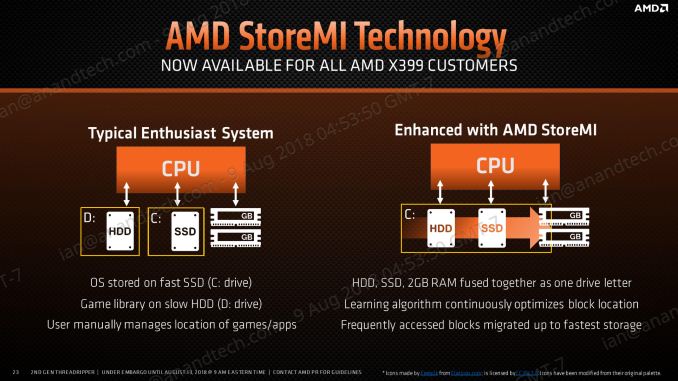The AMD Threadripper 2990WX 32-Core and 2950X 16-Core Review
by Dr. Ian Cutress on August 13, 2018 9:00 AM ESTPrecision Boost 2
Exact per-core turbo timings for the new processors will be determined by AMD’s voltage-frequency scaling functionality through Precision Boost 2. This feature, which we covered extensively in our Ryzen 7 2700X review, relies on available power and current to determine frequency, rather than a discrete look-up-table for voltage and frequency based on loading. Depending on the system default capabilities, the frequency and voltage will dynamically shift in order to use more of the power budget available at any point in the processor loading.
The idea is that the processor can use more of the power budget available to it than a fixed look up table that has to be consistent between all SKUs that are stamped with that number.
Precision Boost 2 also works in conjunction with XFR2 (eXtreme Frequency Range) which reacts to additional thermal headroom. If there is additional thermal budget, driven by a top-line cooler, then the processor is enabled to use more power up to the thermal limit and get additional frequency. AMD claims that a good cooler in a low ambient situation can compute >10% better in selected tests as a result of XFR2.
Ultimately this makes testing Threadripper 2 somewhat difficult. With a turbo table, performance is fixed between the different performance characteristics of each bit of silicon, making power the only differentiator. With PB2 and XF2, no two processors will perform the same. AMD has also hit a bit of a snag with these features, choosing to launch Threadripper 2 during the middle of a heatwave in Europe. Europe is famed for its lack of air conditioning everywhere, and when the ambient temperature is going above 30ºC, this will limit additional performance gains. It means that a review from a Nordic publication might see better results than one from the tropics, quite substantially.
Luckily for us we tested most of our benchmarks while in an air conditioned hotel thanks to Intel’s Data-Centric Innovation Summit which was the week before launch.
Precision Boost Overdrive
The new processors also support a feature called Precision Boost Overdrive, which looks at three key areas for power, thermal design current, and electrical design current. If any of these three areas has additional headroom, then the system will attempt to raise both the frequency and the voltage for increased performance. PBO is a mix of ‘standard’ overclocking, giving an all core boost, but gives a single core frequency uplift along with the support to still keep Precision Boost trying to raise frequency in middle-sized workloads, which is typically lost with a standard overclock. PBO also allows for idle power saving with a standard performance. PBO is enabled through Ryzen Master.
The three key areas are defined by AMD as follows:
- Package (CPU) Power, or PPT: Allowed socket power consumption permitted across the voltage rails supplying the socket
- Thermal Design Current, or TDC: The maximum current that can be delivered by the motherboard voltage regulator after warming to a steady-state temperature
- Electrical Design Current, or EDC: The maximum current that can be delivered by the motherboard voltage regulator in a peak/spike condition
By extending these limits, PBO gives rise for PB2 to have more headroom, letting PB2 push the system harder and further. PBO is quoted by AMD as supplying up to +16% performance beyond the standard.
AMD also clarifies that PBO is pushing the processor beyond the rated specifications and is an overclock: and thus any damage incurred will not be protected by warranty
StoreMI
Also available with the new Ryzen Threadripper 2 processors is StoreMI, AMD’s solution to caching by offering configurable tiered storage for users that want to mix DRAM, SSD, and HDD storage into a single unified platform. The software implementation dynamically adjusts data between up to 2GB of DRAM, up to 256 GB of SSD (NVMe or SATA), and a spinning hard drive to afford the best reading and writing experience when there isn’t enough fast storage.
AMD initially offered this software as a $20 add-on to the Ryzen APU platform, then it became free (up to a 256GB SSD) for the Ryzen 2000-series processors. That offer now extends to Threadripper. AMD’s best case scenario is citing a 90% improvement in loading times.













171 Comments
View All Comments
HStewart - Monday, August 13, 2018 - link
"I highly highly doubt that Intel would postpone 10nm just to “shut down AMD""Probably right - AMD is not that big of threat in the real world - just go in to BestBuy - yes they have some game machines. a very few laptops including older generations
Spunjji - Tuesday, August 14, 2018 - link
That is some impressive goalpost moving that you just did *on your own claim*.Intel's issues have nothing to do with AMD, but they will allow a resurgent AMD to become more competitive over time. Pointing to how little of a threat AMD are *right now* and/or making up weird conspiracy theories that place Intel as the only mover and shaker in the entire industry won't change that.
Relic74 - Wednesday, August 29, 2018 - link
Consumer based computers is but a small portion of the market. Servers, millions of them needed every year to fill the demand needed by, well, everyone who hosts a site, government, networking farms a mile long, etc. The server market is huge and is growing almost faster than tech companies can provide. It's why I always thought Apple getting out if the server market was kind of a stupid ideal. All of the servers they ever created were sold before they were even created. I guess the margains were to small for them, greedy bastards. Why only make double the profits when you make 5x with consumer products. Seriously, an iPhone X costs less than $200 to make now, it used to be $250 but now its $200, greedy bastards. Oh, did you know it costs Apple less than $3 to go from 64GB to 128GB, ugh.Ozymankos - Sunday, January 27, 2019 - link
it matters what you consider as costsdo you calculate the shipping costs,the marketing costs,the salaries of everyone involved,the making of new facilities?
Eastman - Tuesday, August 14, 2018 - link
Intel isn't finished. They are still king of single thread performance. We will see if Zen 2 will surpass Intel's single thread performance.seanlivingstone - Monday, August 13, 2018 - link
Do you know that Jensen Huang is Lisa Su's uncle? Intel is done.f1nalpr1m3 - Thursday, October 25, 2018 - link
Expected Results vs Actual:Stats Expected Q3 2018 Results Actual Q3 2018 Results
Revenue($B) $18.1 $19.2
EPS $1.15 $1.40
UnNameless - Tuesday, August 14, 2018 - link
Sadly this is true. AMD tries hard and in the most part succeeds. Intel frankly showed some kind of panic for the niche market of top end processors with that chilled fiasco of a 5 GHz CPU. This means AMD puts quite some pressure onto themOutlander_04 - Tuesday, August 14, 2018 - link
AMD have bounced back very quickly . Mostly because people are starting to accept how over priced intel have beenhttps://wccftech.com/intel-coffee-lake-amd-ryzen-c...
twtech - Wednesday, August 15, 2018 - link
I don't think branding issues is going to stop purchases of AMD chips when they are the best fit for a particular use-case, but the lack of direct access to memory for half of the cores in the 2990wx is going to keep it from being the knockout punch for HEDT that it could have been.Looking at these benchmark results, that has seriously gimped the performance of the 32-core TR to the point where it is slower than the 16 core in some threaded workloads.
Sure, you can just go ahead and buy the 16-core 2950x instead, but then you're reduced back to being in 7980xe territory - albeit at a cheaper price point - but the point is, it's not the clear win that a relatively high clocked 32-core CPU probably could have been without the memory access issue.